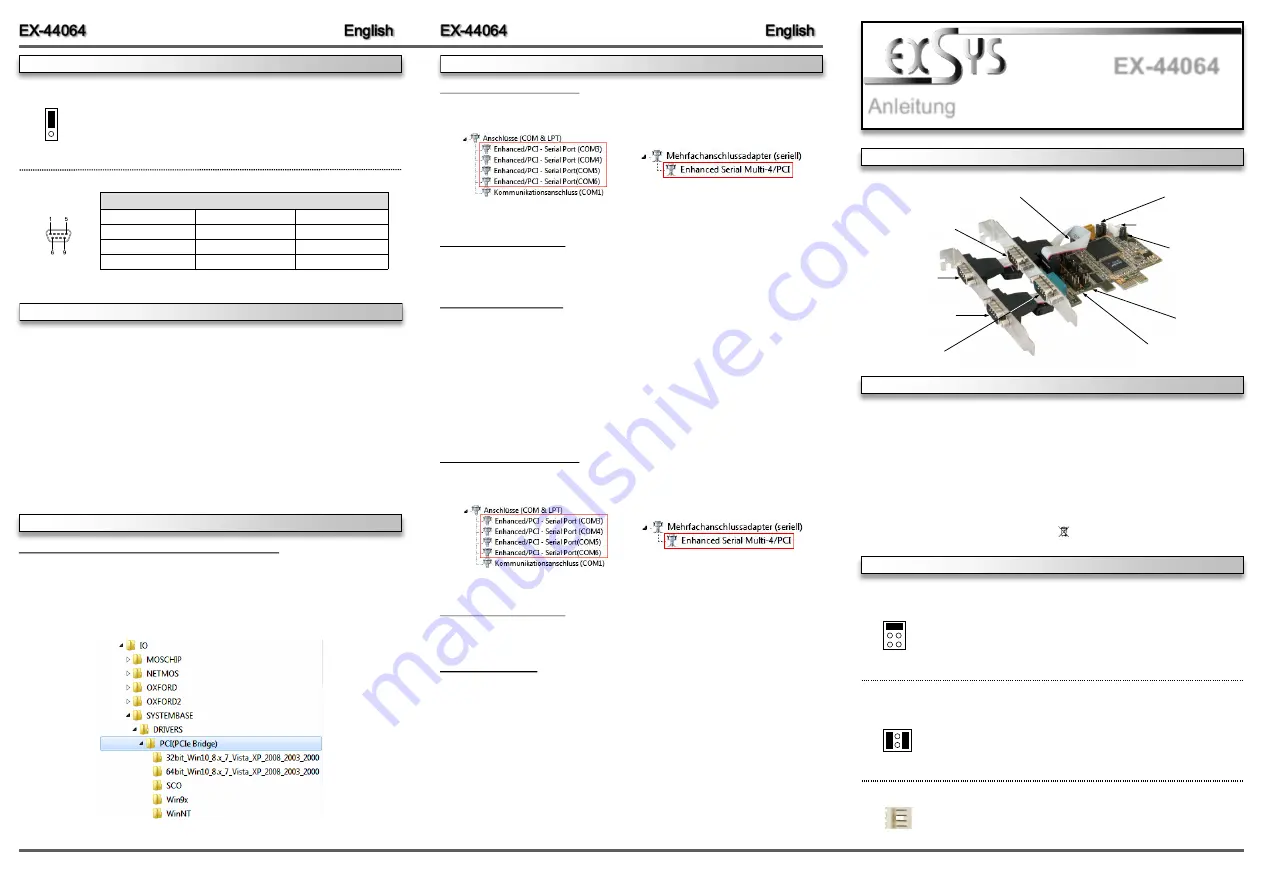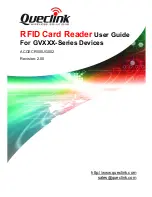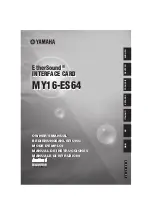
6
5
Die EX
-
44064 ist eine PCI
-
Express serielle RS
-
232 Karte mit 4 seriellen FIFO 16C550 Ports, für
den Anschluss von High
-
Speed seriellen RS
-
232 Peripherie Geräten (z.B. Terminal, Modem,
Plotter usw.). Der serielle PCI
-
Express Bus unterstützt dabei optimal die Leistung des schnellen
Systembase Chipset. Die Karte gewährleistet so eine sichere Datenübertragung und exzellente
Performance von bis zu 115,2KBaud/s! Sie unterstützt alle PCI
-
Express Slots von x1 bis x16.
Es ist nicht möglich die I/O Adressen und Interrupts manuell einzustellen, da die Einstellungen
der Karte vom System (BIOS) und vom Betriebssystem automatisch vorgenommen werden.
1
JUMPER
EINSTELLUNG & ANSCHLÜSSE
BESCHREIBUNG & TECHNISCHE DATEN
S4:
9 Pin Stecker
Serieller Anschluss
AUFBAU
Anleitung
Vers. 1.0 / 12.10.16
EX
-
44064
S1~S4_PWR:
S1:
9 Pin Stecker
Serieller Anschluss
S3:
9 Pin Stecker
Serieller Anschluss
S2:
9 Pin Stecker
Serieller Anschluss
Kompatibilität:
PCI
-
Express x1 bis x16
Betriebssysteme:
Windows NT 4.0/ 9x/ 2000/ XP/ Vista/ 7/ 8.x/ 10/ Server 20xx/ Linux
Anschlüsse:
4x 9 Pin Seriell D
-
Sub Stecker
Lieferumfang:
EX
-
44064, Treiber CD, Anleitung, Bügel mit 2x 9 Pin Kabel
Zertifikate:
CE
/
FCC / RoHS / WEEE DE97424562 / WHQL
RI
=
Am Pin 9 liegt das Standard Signal RI (Ring Indicator)
(Werkseinstellung)
5
=
Am Pin 9 liegt jetzt eine Spannung von DC5V an
12
=
Am Pin 9 liegt jetzt eine Spannung von DC12V an
Die Einstellung der Spannung nehmen Sie mit dem JP1 vor. Dies sollte
aber bei Standard Anwendungen nicht verstellt werden.
JP1:
Wenn Sie den Jumper S1~S4_PWR auf 5 oder 12 gesetzt haben,
können Sie mit dem Jumper JP1 den Spannungswert einstellen. Es gibt
3 verschiedene Spannungsquellen.
(Nur in Verbindung mit S1~S4_PWR auf 5 oder 12!!!)
X5
=
5Volt vom PC
-
Netzteil
(Werkseinstellung)
X12
=
12Volt vom PC
-
Netzteil
I12
=
12Volt vom Mainboard
(Werkseinstellung)
I12 X12 X5
J2:
1 +5V
2 GND
3 GND
4 +12V
Für AUX Einstellung (JP1) muss J2 mit dem PC Netzteil verbunden
werden! Sonst wird die Karte nicht mit Strom versorgt.
RI
5
12
S2~S4
-
PH:
Interner serieller Anschluss
S1~S4_PWR:
Power auf 9 Pin
Stecker Ein/Aus
JP2:
Nur für
Testzwecke
J2:
Anschluss für Strom
vom PC Netzteil
JP1:
Jumper für die Stromquelle
(Netzteil oder PCI
-
Express Bus)
JP3:
PME
Ein
-
/ Ausschalten
If you are ready with the jumper settings, please proceed with the following installation instructions.
Because there are large differences between PC
’
s, we can give you only a general installation
guide. Please refer to your computer
’
s reference manual whenever in doubt.
1.
Turn off the power to your computer and any other connected peripherals.
2.
Remove the mounting screws located at the rear and/ or sides panels of your Computer and
gently slide the cover off.
3.
Locate an available expansion slot and remove its covers from the rear panel of your comput-
er. Make sure it is the right expansion slot for the card (see card description)
4.
Align the card with the expansion slot, and then gently but firmly, insert the card. Make sure
the card is seated and oriented correctly. Never insert the card by force!
5.
Then connect the card with a screw to the rear panel of the computer case.
6.
Gently replace your computer
’
s cover and the mounting screws.
DB 9M:
Serial 9 Pin D
-
SUB Connector
Pin
Signal
Pin
Signal
Pin
Signal
1
CDC
4
DTR
7
RTS
2
RXD
5
GROUND
8
CTS
3
TXD
6
DSR
9
RI
Windows NT 4.0/ 9x/ 2000/ XP/ Vista/ 7/ 8.x/ 10
After completing the hardware installation, the operating system will automatically the card and
install this! If the driver should not be installed automatically, insert the driver CD into you CD
-
ROM drive (eg drive D:) and then open the folder
„
IO/SYSTEMBASE/DRIVERS/PCI(PCIe
Bridge)
“.
Please select the folder with your operating system and install the driver (see Picture).
Follow the hardware assistant and finish the installation.
Important!
Restart your PC in any
case after installing the drivers.
JUMPER
SETTING & CONNECTORS
HARDWARE
INSTALLATION
DRIVER INSTALLATION
DIS
=
The function PME is disable. (Factory Setting)
ENA
= The function PME is enable. Now the card can be activate
the computer through the serial ports.
But this should not be adjusted for standard applications.
DIS
—
ENA
JP3:
CHECK INSTALLED DRIVER
Open the >
Device manager
<. Now you should see at
„
Ports (COM & LPT)
“
and at
„
Multifunction Adapter
“
the following new entry's:
If you see this or a similar information the device is installed correctly.
CHANGE PORT NUMBER
If you like to change the port number for example COM3 to COM5, open the
„
Device Manager
”
click at
„
COM3
”,
„
Settings
”
and then
„
Advance
”.
There you can change between COM3 till
COM256.
Windows Server 20xx
After completing the hardware installation, the operating system will automatically the card and
install this! If the driver should not be installed automatically, insert the driver CD into you CD
-
ROM drive (eg drive D:) and then open the folder
„
IO/SYSTEMBASE/DRIVERS/PCI(PCIe
Bridge)
“.
Please select the folder with your operating system and install the driver (see Picture).
Follow the hardware assistant and finish the installation.
Important!
Restart your PC in any
case after installing the drivers.
Use the following driver for the following Windows Server Version.
Windows Server 2003
=
XP Driver
Windows Server 2008
=
VISTA Driver
Windows Server 2008R2
=
Windows 7 Driver
Windows Server 2012
=
Windows 8.x Driver
Windows Server 2012R2
=
Windows 10 Driver
CHECK INSTALLED DRIVER
Open the >
Device manager
<. Now you should see at
„
Ports (COM & LPT)
“
and at
„
Multifunction Adapter
“
the following new entry's:
If you see this or a similar information the device is installed correctly.
CHANGE PORT NUMBER
If you like to change the port number for example COM3 to COM5, open the
„
Device Manager
”
click at
„
COM3
”,
„
Settings
”
and then
„
Advance
”.
There you can change between COM3 till
COM256.
Linux / SCO Unix
The drivers are located in the following folder on our driver CD:
"IO/SYSTEMBASE/DRIVERS/PCI(PCIe Bridge)/SCO"
Because each individual distribution and kernel version of Linux is different, sadly we cant
provide a installation instruction. Please refer to the installation manual for standard IO ports
from your Unix/Linux version! In some newer versions of Linux the card will even be installed
automatically after starting Linux.
DRIVER INSTALLATION




















